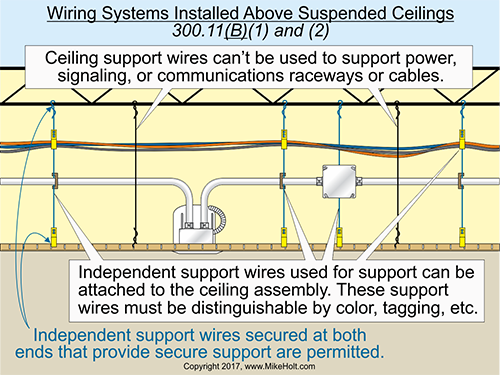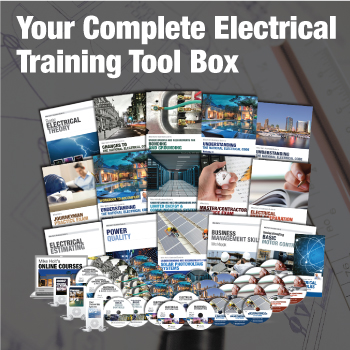|
Note: The answers to these questions are based on the 2017 NEC®.
Underlined text indicates a change in the rule for the 2017 NEC.
Q1. What are the NEC requirements for raceways exposed to different temperatures?
A1. If a raceway is subjected to different temperatures, and where condensation is known to be a problem, the raceway must be filled with a material approved by the authority having jurisdiction that will prevent the circulation of warm air to a colder section of the raceway. An explosionproof seal isn't required for this purpose [300.7(A)]. Putty or duct seal in the raceway is a typical method to accomplish this requirement. Š
Where necessary to compensate for thermal expansion, deflection, and contraction, raceways must be provided with expansion, expansion-deflection, and deflection fittings. [300.7(B)].
Informational Note: Table 352.44 provides the expansion characteristics for PVC conduit. The expansion characteristics for steel conduit are determined by multiplying the values from Table 352.44 by 0.20, and the expansion characteristics for aluminum raceways are determined by multiplying the values from Table 352.44 by 0.40. Table 354.44 provides the expansion characteristics for reinforced thermosetting resin conduit (RTRC).
Q2. What are the Code requirements for supporting wiring systems installed above suspended ceilings?
A2. The ceiling support wires or ceiling grid aren't permitted to be used to support raceways and cables (power, signaling, or communications). However, independent support wires that are secured at both ends and provide secure support are permitted [300.11(B)]. Figure 01Š
Author's Comment:
Outlet boxes [314.23(D)] and luminaires can be secured to the suspended ceiling grid if securely fastened to the ceiling framing members by mechanical means such as bolts, screws, or rivets, or by the use of clips or other securing means identified for use with the type of ceiling framing member(s) used [410.36(B)].
Electrical wiring within the cavity of a fire rated floor ceiling [300.11(B)(1) or a nonfire rated ceiling assembly [300,11(B)(2) can be supported by independent support wires attached to the ceiling assembly. The independent support wires must be distinguishable from the suspended ceiling support wires by color, tagging, or other effective means.
Q3. What are the Code rules in regard to raceways used for support of other raceways, cables, or nonelectrical equipment?
A3. Raceways aren't permitted to be used as a means of support for other raceways, cables, or nonelectrical equipment, except as permitted in (1) through (3) [300.11(C)].
(1) Identified. If the raceway or means of support is identified as a means of support.
(2) Class 2 and 3 Circuits. Class 2 and 3 cables can be supported by the raceway that supplies power to the equipment controlled by the Class 2 or 3 circuit.
(3) Boxes Supported by Raceways. Raceways are permitted as a means of support for threaded boxes and conduit bodies in accordance with 314.23(E) and (F), or to support luminaires in accordance with 410.36(E).
Cables aren't permitted to be used to support other cables, raceways, or nonelectrical equipment [300.11(D)].
Q4. What are the NEC rules regarding mechanical continuity of raceways and cables sheaths?
A4. Raceways and cable sheaths must be mechanically continuous between boxes, cabinets, and fittings [300.12].
Ex 1: Short sections of raceways used to provide support or protection of cable from physical damage aren't required to be mechanically continuous [250.86 Ex 2 and 300.10 Ex 1].
Ex 2: Raceways at the bottom of open bottom equipment, such as switchboards, motor control centers, and transformers, aren't required to be mechanically secured to the equipment.
Author's Comment:
When raceways are stubbed into an open bottom switchboard, the raceway, including the end fitting, can't rise more than 3 in. above the bottom of the switchboard enclosure [408.5].
Q5. What is the Code requirement for supporting conductors in vertical raceways?
A5. If the vertical rise of a raceway exceeds the values of Table 300.19(A), each conductor must be supported at the top, or as close to the top as practical. Intermediate support must also be provided in increments that don't exceed the values of Table 300.19(A).
Author's Comment:
The weight of long vertical runs of conductors can cause the conductors to actually drop out of the raceway if they aren't properly secured. There've been many cases where conductors in a vertical raceway were released from the pulling "basket" or "grip" (at the top) without being secured, and the conductors fell down and out of the raceway, injuring those at the bottom of the installation.
|



